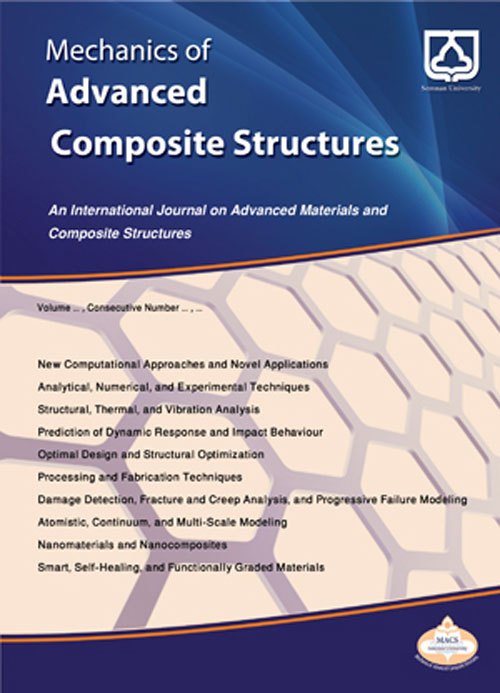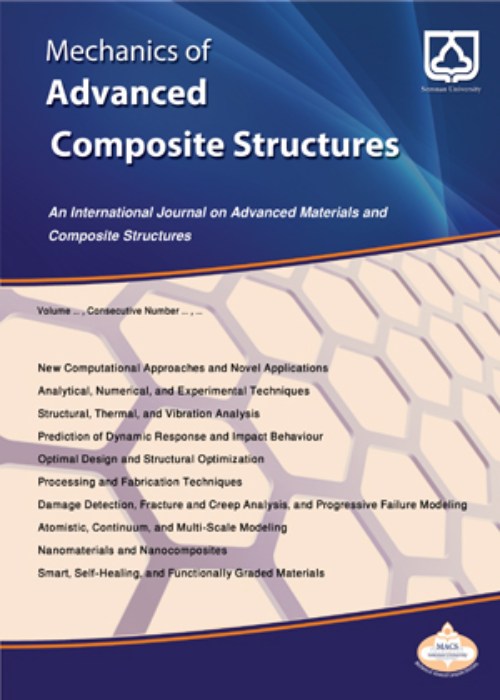فهرست مطالب

Mechanics of Advanced Composite Structures
Volume:4 Issue: 3, Summer and Autumn 2017
- Special Issue
- تاریخ انتشار: 1396/10/07
- تعداد عناوین: 7
-
-
Pages 179-186In this research, thermoplastic polyurethane (TPU) and clay nanoparticles were incorporated into poly (butylene terephthalate) (PBT) to improve the impact and tensile properties. The PBT/TPU (90/10, 80/20 and 70/30) samples were prepared by melt mixing using a co-rotating twin-screw extruder followed by injection molding. At the next stage, clay nanoparticles of different weight fractions were added to the PBT/TPU (80/20) blend in the same way to prepare nanocomposite samples. SEM images illustrated good compatibility between TPU and PBT. To characterize the dispersion of clay layers in the polymer matrix, wide-angle X-ray diffraction (WAXD) inspections were performed. The results of the mechanical assessments showed that the addition of TPU to PBT significantly increased the impact strength but decreased the tensile strength and modulus. Incorporating clay nanoparticles into the PBT/TPU blend noticeably improved the tensile properties of PBT/TPU-based nanocomposites. A balance of the tensile and impact properties was found in the PBT/TPU/clay (80/20/3) nanocomposite system.Keywords: Tensile properties, poly (butylene terephthalate), thermoplastic polyurethane, clay nanoparticle
-
Pages 187-196In this article, the effect of hygrothermal aging on mechanical properties of fiber metal laminates (FMLs) and E-glass/epoxy (GE) composites is investigated. First, FML and GE specimens were built using wet lay-up technique under vacuum pressure. Hygrothermal aging simulation was then carried out on both specimen types in distilled water at a constant temperature of 90 °C for 5 weeks. The resulting behavior of degradation for both types of specimens caused by hygrothermal aging was evaluated by bending and Charpy impact testing. As expected, because of the protective role of aluminum layers, FML specimens showed remarkably lower water absorption after hygrothermal aging compared to the glass/epoxy composites. Experimental results also revealed that the flexural properties of both the FML and GE laminates were affected by the hygrothermal aging, whereas a lower level of deterioration in impact strength was found.Keywords: Fiber metal laminates (FMLs), Glass-epoxy composites, Hygrothermal aging, Impact properties, Flexural properties
-
Pages 197-205The aim of this study is to investigate effects of isothermal aging on mechanical properties of fiber metal laminates (FMLs) and glass/epoxy composites. For this purpose, both materials were fabricated using the wet lay-up manufacturing technique under vacuum pressure. Both the glass/epoxy composites and the FML specimens were then subjected to isothermal aging (130°C, dried air) for up to 5 weeks. After the isothermal aging, the specimens weight loss, caused by thermo-oxidative conditioning, was evaluated. Bending and Charpy impact tests were conducted on both the unaged and aged specimens to examine the isothermal conditionings effect on the mechanical properties of studied materials. Experimental results revealed that isothermal aging severely affected impact strength in the form of embrittlement and reduced ductility. However, no significant reduction was found in the flexural stiffness of isothermally aged FML and glass/epoxy specimens.Keywords: Fiber metal laminates (FMLs), Glass, epoxy composites, Iso-thermal aging, Impact properties, Flexural properties
-
Pages 207-210In this study, the behavior of filament wound nanocomposite tubes under transverse impact loading is investigated. Experimental specimens were manufactured using Epon 828 resin with 0.5, 1.5 and 3 weight percentages of nano silica. Because of the varying nanosilica weight percentages in the specimens, different behaviors were observed; increasing the weight percentage of nanoparticles increased impact strength. A ballistics test was performed with a gas gun, with projectile entry and exit speeds carefully recorded. All tests were carried out with projectiles with a mass of 9.3 grams at a speed of 130 meters per second. Failure of fiber, output velocity, damage area, and effects of varying percentages of nanoparticle content on resistance of the cylindrical shells under ballistic impact at various velocities are derived and presented. The final results are analyzed and compared.Keywords: Composite cylindrical shell, Nanocomposite, Ballistic impact
-
Pages 211-223In this paper, experimental and Finite Element Methods have been used to determine mechanical properties of nanocomposites. Standard tensile and compression samples with 0.0, 0.15, 0.25, 0.35, 0.45, and 0.55 weight fraction of Multi-Walled Carbon Nanotube (MWCNT) were prepared and tested. Nanotube weight fraction was varied to investigate the effects of nanotube weight fraction on nanocomposite mechanical properties. Mechanical properties such as: modulus of elasticity, yield strength, ultimate tensile strength, and fracture strain were determined experimentally. Experimental results showed that incorporation of carbon nanotubes improves modulus of elasticity, and yield and ultimate strengths of the epoxy resin under tension and compression. Results also showed that fracture strain decreases drastically with increasing nanotube weight fraction. Field Emission Scanning Electron Microscope (FESEM) was used to obtain images of the samples fracture surfaces. These images showed a good MWCNT dispersion in the matrix. Also, numerical simulations were conducted in Abaqus software. In these simulations, the effects of the interface between individual nanotubes and the outer nanotube and matrix were investigated. Two different models were used for these interfaces. Connector constraints were used in the first model and thin shells in the second model. The connector model predicted lower mechanical properties compared to the thin shell interface model. Finally, experimental and numerical results were compared and a good correlation was observed between the results.Keywords: Multi-Walled Carbon Nanotube, Nanocomposite, Compressive Properties, experimental, Connector Constraint
-
Pages 225-232This paper presents an experimental investigation into the compression behavior of shape memory alloy hybrid composites (SMAHC) subjected to quasi-static loading taking into account of rotation effects of shape memory wire in basalt continuous filament (BCF) direct roving epoxy composite. Two types of specimen prepared, the BCF direct roving reinforced epoxy composite filled with shape memory wire and BCF direct roving reinforced epoxy composite without shape memory wire and compression strengths of two specimens per type are analyzed. Specimens were prepared by hand layup at room temperature for curing. For composites specimen four layer BCF direct roving reinforced epoxy composite prepared. The effect of shape memory wire on the maximum load bearing capacity of resultant specimens after quasi static damage was experimentally investigated. Results of compression test for two specimens per type of BCF and SMAHC showed that composite specimens with four layer BCF direct roving reinforced epoxy composite has higher load than SMAHC specimens with rotate wire between second and third layer. It may for weak interface between shape memory wire and matrix due to the discrepancy in compatibility of materials.Keywords: Shape memory alloy, Basalt, Compression, Hybrid composites
-
Pages 233-237Although titanium/hydroxyapatite composite is an attractive material for dental implants, it would be more useful if it could be produced as a functionally graded material (FGM). In this paper, microstructure and microhardness of a five-layer titanium/hydroxyapatite functionally graded material has been investigated. First, titanium and hydroxyapatite (HA) powders were mixed with the Ti to HA volume ratios of 100:0, 90:10, 80:20, 70:30 and 60:40. Next, the obtained powders were poured into a graphite mold functionally and then sintered using spark plasma sintering (SPS) method. Microhardness and microstructure of the samples was examined using Vickers microhardness test and optical microscopy. The results show that HA particles have an acceptable distribution in the matrix. Also, average matrix grain size increased in Ti/HA composites compared to the pure Ti layer. Moreover, the layers with 30 and 40 vol% HA have the highest and the lowest microhardness, respectively.Keywords: Titanium-Hydroxyapatite, Functionally graded materails, Powder metallurgy, Spark plasma sintering (SPS)


